Understanding Chronic Pain: An Ongoing Challenge
Chronic pain affects millions of people worldwide, profoundly impacting daily life and well-being. Lasting beyond three to six months, it is a complex condition involving physical, psychological, and social factors. This article explores evidence-based, long-term strategies for managing chronic pain, emphasizing a multidisciplinary approach that addresses symptoms, underlying causes, and quality of life improvements. We delve into causes, diagnosis, treatments, and innovative coping mechanisms, empowering individuals and caregivers with knowledge to navigate this persistent health challenge.
<!-- VIDEO:eyJsaW5rIjoiaHR0cHM6Ly93d3cueW91dHViZS5jb20vd2F0Y2g/dj1WUEowcmNsbTZqcyIsImltYWdlVXJsIjoiZGF0YTppbWFnZS9qcGVnO2Jhc2U2NCwvOWovNEFBUVNrWkpSZ0FCQVFBQUFRQUJBQUQvMndDRUFBa0dCd2dIQmdrSUJ3Z0tDZ2tMRFJZUERRd01EUnNVRlJBV0lCMGlJaUFkSHg4a0tEUXNKQ1l4Sng4ZkxUMHRNVFUzT2pvNkl5cy9SRDg0UXpRNU9qY0JDZ29LRFF3TkdnOFBHamNsSHlVM056YzNOemMzTnpjM056YzNOemMzTnpjM056YzNOemMzTnpjM056YzNOemMzTnpjM056YzNOemMzTnpjM056YzNOLy9BQUJFSUFGTUFsQU1CSWdBQ0VRRURFUUgveEFBY0FBRUFBUVVCQVFBQUFBQUFBQUFBQUFBQUJ3SUVCUVlJQVFQL3hBQkRFQUFCQXdJREF3VU9Bd1VKQUFBQUFBQUJBQUlEQkJFRkJoSVRJVEZCVVZhVTBnY0lGQllZSWpJMllYRjBrY0xSSTRHeE16VkNzc0VWRnlSaVkzS0NvdUgveEFBWEFRRUJBUUVBQUFBQUFBQUFBQUFBQUFBQUFnRUQvOFFBSFJFQkFBSURBQU1CQUFBQUFBQUFBQUFBQUFFQ0VSSWhJakV5QS8vYUFBd0RBUUFDRVFNUkFEOEFnMUZ2L2M4N21jMmQ4TnFxeUxGV1VZcDV0bG9kQVg2dk5CdmU0NTF0bmsvVlBTT0hxaDdhQ0ZFVTErVDlVOUk0ZXFIdHA1UDFUMGpoNm9lMmdoUkZOZmsvVlBTT0hxaDdhZVQ5VTlJNGVxSHRvSVVSVFg1UDFUMGpoNm9lMm5rL1ZQU09IcWg3YUNGRVUxK1Q5VTlJNGVxSHRwNVAxVDBqaDZvZTJnaFJGTmZrL1ZQU09IcWg3YWVUOVU5STRlcUh0b0lVUlRYNVAxVDBqaDZvZTJ0RTdvdVJaTWoxZEhUeTE3S3p3cU56dzVzV2pUWTI1eWcwOUVSQVJFUUVSRUhRdmUyK3JHSy9IZlExUzhvaDcyMzFZeFg0NzZHcVhIa2hwTFJjODNPZ3FSRmJOcjZSOHI0V1ZVRHBXT0RIc0VnMU5jZUFJNUQ3RUZ5aUtneXNiSzJJdmFKSE5MbXN2dklGcmtEbTNqNWhCV2lLaHNySFNPakQybVJvQmMwSGVBZUZ4K1IrU0N0RlEyV043M3NhOXBleTJ0b2NDVzMzaS9NcTBCRjQxelhYMGtHeHNiSGdWNmdLQWUrVi9mR0NmRHlmekJUOG9ENzVKcGZqV0J0YUM1enFlUUFBWEpPb0lJWVJYek1IeFIvb1liV085MERqL1JldXdYRlcrbGhsYVBmVHYreUN3UlpCbUI0dS93QkRDcTUzdXBubitpOWt3TEdJbWE1TUtyMk52YTdxWjRINklNY2krMGxKVVJ1MHlRU3Nkek9ZUVVRVC93QjdiNnNZcjhkOURWTHlpSHZiZlZqRmZqdm9hcGVRRnFqc3N0bmtscGZEcWQwVWN1MkVUYWNiVnV0NWVkYnRWemM4T0hEbFd4WWxUZUcwRlJTbDJnVFJ1WVhjMXhibkg2cldSa3ZWSEV5b3hIYTdOZ1lCc0xEY1RhdzFidHhzZ1B5eExUR0NwbHhwekhzbEcwbGsxQU91WXdMZWRZTzgwdEIzajhRN2lxWThuVk1jY1RCaXBkczJBRnIyUExYdS9DMUYzbjNzVEVTUmYrTDUvS0xLYi83UW1pbHI0ZEhtT2pqRVpMNUkyNk56dDlnMEZwRnJIa04rUmZXREwxUlBsK09sRlJUdm1kV21TWnozbVpqV3RCWUdjUnFMV3RhMGk0M2dvTG5Fc0FyNnVyaWN5dkVFY1ZJMkl6QU9MaTRhcjJHcmNEY1h2Zm12eXF6cE1wVFMwa1RtNDN0V21MOEtXTnJyZnhscmhaKzhEV0xmN1Y5bVpTakU4WWp4UXVxWVg3U1o3bWFwQ0NXMlBwZWE3ekNOVmpjT2R1Vk1PU2hHR3h5WWhyaERZdzlteHR0Tk9uYzd6dDdiTnNCeWFqeHVndnEvTDFSVVkxSGlNT0lHSU5tWklZOUJOdzBOQkhwVzNodkczTDg3ZXV5NitveEdwZEhpald5VEV5bW5lSEVFYW1hZFFEd2RJMHU0VzN1OTk4V01vVmxWVTFVTHNTaDJiR05adHhlU1I4Z0VaL0ViZmdBMjRGOTF4eFdZcGNyR0IySVh4QjU4TWdmRnRBeTByZFJKMUYrcnppTDJHNGJnQnlYUVgrWDhJZmhFTThiNmcxSmxsRWhrYzJ6bkhRMXBMdCs4a3RKL05aZGE5bDNBNGFLcGZXQ3JqcVhhREEwUlI2R1Eya2VYTllOUnNMa0MzSnA0cllVQlFqM2RJWFZHZDhwUU05S1I0WUw4NWxhRk55aGp1ek8wZDBUSlR6L0RPdzhQOVppQ1FNRHlqaDlIUnRGU3piU2tYY1NTQVBZTExYYy81ZGxwTU9FbURTdVkrVjRqR3B1dlozdWJqbjRjRHlySitPRkFaNFlabVR0dThSQiswZTNlWGFRU0I3U0ZGbVBaK3I2dk41dzNEYXVTREI0NjRSYkZqaitLTmVseGNia2tFNmorWVYwck04Um1zOWZmSmsrUDAyUFB3OTViWFRlbEE5N0FBNnhzNE81TExPWTlVNHpWVXNFK0t4VThjRWhMb2ZCcmFEY0RlT1g1cUxNNFYxUTJ2Z01VNzIzWTl3TWIzQzRNamh6L0FPVmU1WHJwcVlTaW9tZXlta1kzUTE3N3RGcjhPYi8xUit0SXJaMmljOGg4OFplS3F2a2tlQUxlYUFEeUJlTElWTkZUT2wxTmU0aHd2dWRkRkd0bTdWU2YzdHZxeGl2eDMwTlV2S0llOXQ5V01WK08raHFsNVc1c1ZtVERINHRoemFXTXcvdG8zdTJ6TlRkTFhBbTdlWDNjcXcxUGtlbmpuRDU2eVNwajFSdWN5Vmw5WlkwanpqZmY3TjI3MnJia1FhWWNpTThBYlNqRUxCaHZIL2h4cFp2dUxDL0p2NG5pZnlWVXVSWVgxRXNvcm50RWdsYVFJZ056eTQyNDhtdm0zNlc4TExjVVFhMUhsT0tLbnhHQ0tkcldWc095L1lEOE1hM3VBRy9nQS9UYm1BNEszZ3lZSUdBUjE0MWdSNlpIVTRMZ1dPYVdpOTc2UE45SG5KTjF0cUlOUXBNa1JVMVZSenNyWDNwcEdQM1JXTDlMV0E3d2VYWi9Kemh5cW10eVc3RUphOTgxV3lFVk14ZUd4d2gxeHFCQmNTZDVGdDNOdjQzVzRvZzFxZ3lwSFI0cEhpSGhicEptU0Y5ekh2c1RLUzI5K0JNb1AvQUxaVVJBVUVkOFBVdm84eTVkcW92VGdqZEkzM3RlQ1AwVTdxQWUrVi9mR0NmRHlmekJCSEZibTNHYTZhS1d0cXpLWVhoMFFzR2hsamNjQnpnY2JyRjBWV2Fhc2lxUzNXWTNoOWliWElWcWkyTFRIcG1GN1cxcHE5Z1hzQU1VV3o0M3Z2SnYvd0JsN0RYbUtsRU9nR3hOamRXS0xMK2YwcXRwck9ZWFFxckRkdEcreHNsaCtpSzFSWmh1MHB4N2d1WThFd1hMK0pRNHRpdEpSeVByTlRHVHlocGNORFJjWFVuK1B1VWVrZUdkWmF1UDBXcGRnZVB1VWVrZUdkWmF2UEgzS1hTUERPc3RYSUNJT3dQSDNLUFNQRE9zdFhuajdsTHBIaGZXV3JrQkVIWUhqN2xMcEhoZldXL2RQSDNLUFNQQytzdCs2NC9SQjJCNCs1UjZSNFgxbHYzVHg5eWowand2ckxmdXVQMFFkZk96OWxJYmhtSERUN3FsdjNYeWh6N2xSbDlXWWNOTnpmZFV0KzY1R1JCMTcvZUJsTHBCaDNXR2ZkUXgzZk1jd3JITVR3bVRDYStuckd4d1NCNWdrRGcwNmhhOWxGS0lDSWlBaUlnSWlJQ0lpQWlJZ0lpSUNJaUFpSWdJaUlDSWlBaUlnSWlJQ0lpRC85az0iLCJ0aXRsZSI6IlN0cmF0ZWdpZXMgZm9yIENvcGluZyB3aXRoIENocm9uaWMgUGFpbiAtIDIwMjMiLCJzbmlwcGV0IjoiTWVldCBhbmQgZGlzY3VzcyBkaWZmZXJlbnQgd2F5cyB0byBjb3BlIHdpdGggY2hyb25pYyBwYWluIGFuZCB3aGF0IHdlIGtub3cgZnJvbSB0aGUgc2NpZW5jZSBhbmQgYW5kIHJlc2VhcmNoIHN1cnJvdW5kaW5nIGNocm9uaWMgcGFpbiBtYW5hZ2VtZW50LiJ9 -->Causes and Symptoms of Chronic Pain: A Multifaceted Condition
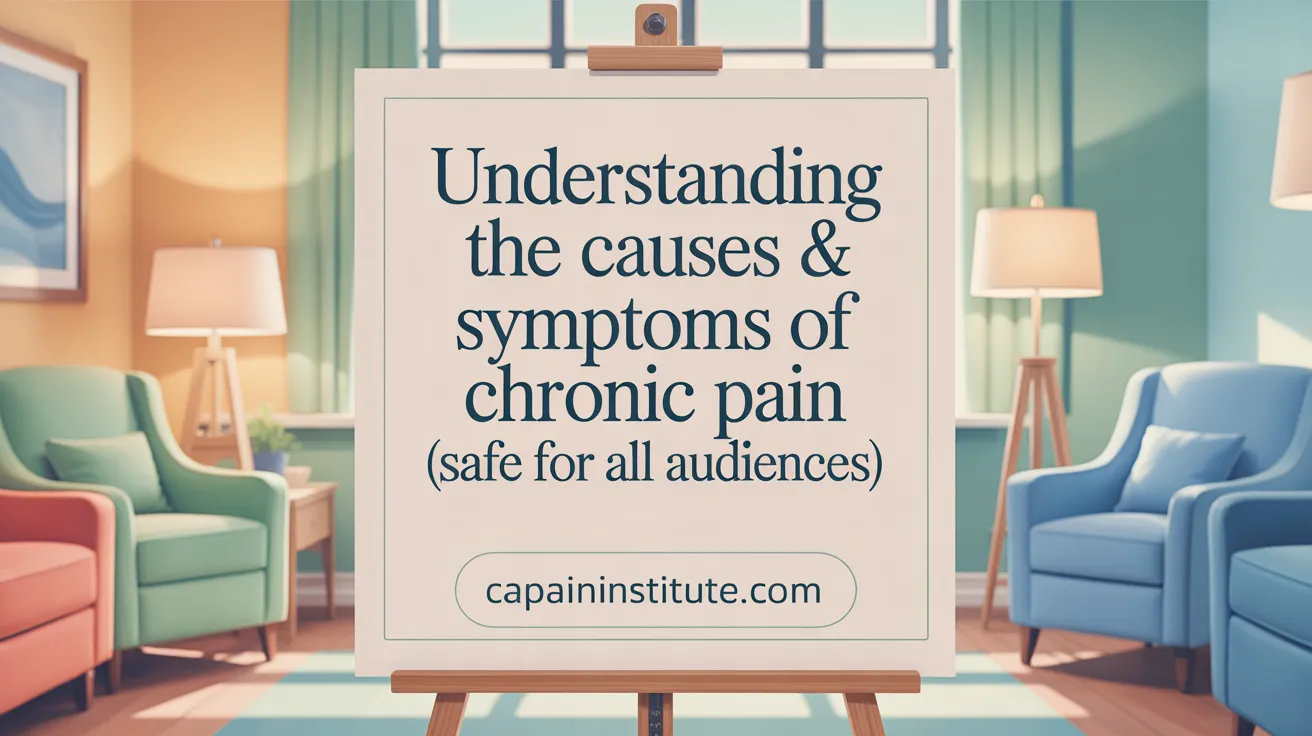
What are the common causes and symptoms of chronic pain?
Chronic pain is defined as a persistent or episodic sensation that lasts longer than three to six months. Unlike acute pain, which signals injury or illness and tends to resolve as healing occurs, chronic pain often continues beyond the normal recovery period. It can stem from various underlying issues, including arthritis, nerve damage, autoimmune diseases, injuries, or sometimes no clear cause is identifiable.
Common causes of chronic pain include:
- Neuropathic pain resulting from nerve damage or dysfunction.
- Musculoskeletal issues like joint problems, muscle strains, or spinal conditions.
- Inflammatory conditions such as rheumatoid arthritis or other autoimmune disorders.
- Visceral pain originating from internal organs.
- Central sensitization, where the nervous system becomes overly reactive.
The symptoms associated with chronic pain are diverse and can fluctuate over time. Typical sensations include aching, burning, shooting, stabbing, squeezing, stiffness, or throbbing. These sensations can significantly impair daily activities, reduce mobility, and lower overall quality of life.
Beyond physical discomfort, chronic pain often influences mental health, contributing to anxiety, depression, fatigue, and sleep difficulties. This complex interplay underscores the need for a comprehensive treatment approach.
Managing chronic pain effectively involves identifying its root cause when possible and tailoring a multifaceted treatment plan. This plan may include medications, physical therapies, psychological support, and lifestyle modifications to help control symptoms and restore a better quality of life.
For more detailed information on causes and symptoms, searching
Diagnosing Chronic Pain: Comprehensive Evaluation and Tools
 The process of diagnosing chronic pain involves a thorough and multi-faceted approach by healthcare professionals.
The process of diagnosing chronic pain involves a thorough and multi-faceted approach by healthcare professionals.
Initially, doctors gather a detailed medical history, focusing on the pain’s specific characteristics such as its location, intensity, duration, and how it affects daily life. This helps create a clear picture of the patient’s condition.
Next, a physical exam is performed to identify any possible physical issues or anomalies that could be contributing to the pain. During this assessment, clinicians may evaluate factors like neurological function, muscle strength, and joint mobility.
To uncover underlying causes, a variety of medical tests and imaging techniques are used. These may include MRI, CT scans, ultrasound, and blood tests. Nerve conduction studies and electromyography (EMG) help assess nerve and muscle function. Advanced neuroimaging methods, such as functional MRI (fMRI), can observe brain activity linked to pain perception.
Because pain is a subjective experience, healthcare providers often rely on pain assessment scales and questionnaires. Patients may rate their pain intensity on a numerical scale or describe its quality and impact through specific surveys. These self-reports are crucial for understanding how pain affects their mental and emotional well-being.
In some cases, diagnostic procedures like nerve blocks, discography, or myelograms are employed. These help pinpoint specific pain sources, especially when initial assessments are inconclusive.
Diagnosis often involves collaboration among specialists from different fields, such as neurologists, rheumatologists, pain clinicians, and radiologists, to form a comprehensive understanding of the patient’s condition.
Through this multi-pronged approach, healthcare providers can develop personalized treatment plans aimed at managing and alleviating chronic pain effectively.
For more information on this topic, consider searching for "chronic pain diagnosis methods" to find detailed resources and recent advancements in diagnostic techniques.
Pharmacological and Nonpharmacological Treatment Options
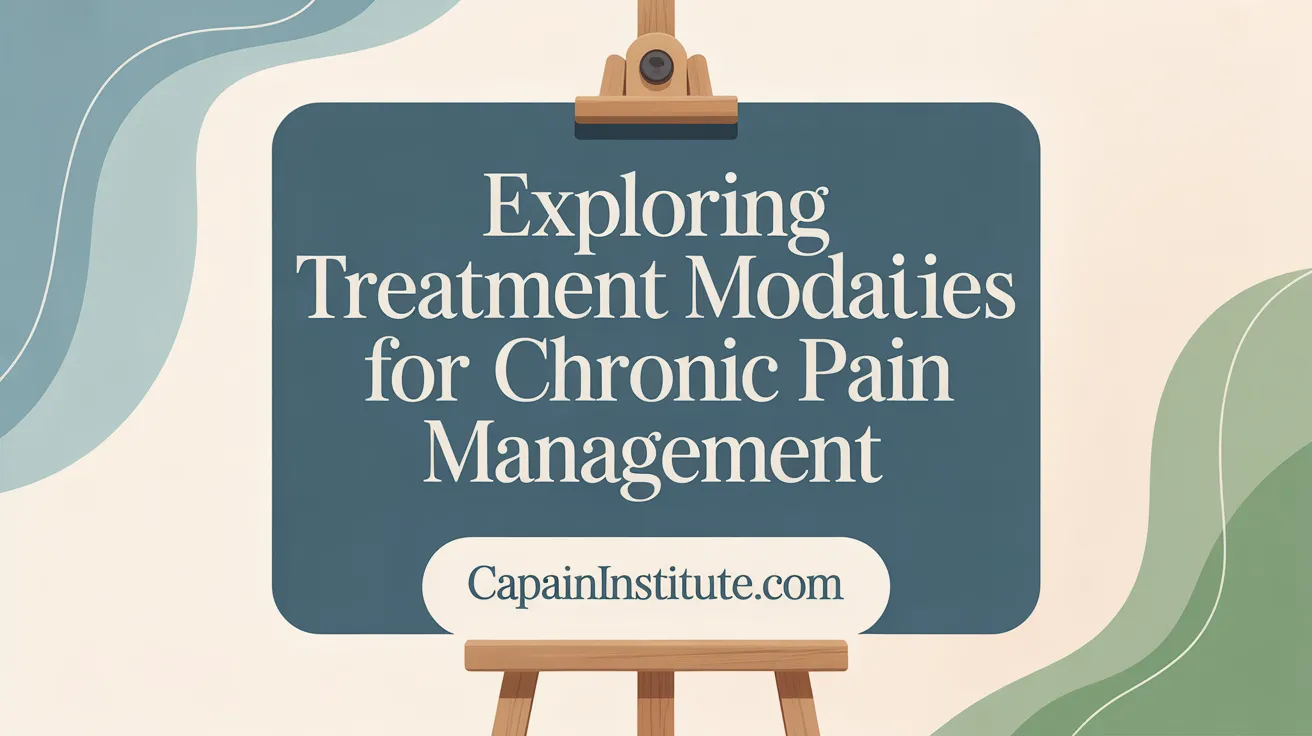
What are the main treatment options available for managing chronic pain?
Managing chronic pain involves a mix of medications and therapies tailored to individual needs. The primary goal is to reduce pain, improve function, and enhance overall quality of life.
Medications play a significant role and include NSAIDs (such as ibuprofen), acetaminophen, COX-2 inhibitors, antidepressants, anticonvulsants, and opioids. Each type targets specific pain mechanisms and severity levels, but their use must be carefully managed to avoid side effects and dependency.
However, reliance solely on medicines is often insufficient. Nonpharmacological strategies are equally vital. These include physical therapies like massage, heat or cold packs, hydrotherapy, and exercise routines such as walking, swimming, or yoga. Such activities help strengthen muscles, improve flexibility, and reduce pain signals.
Mind-body approaches are also beneficial. Cognitive-behavioral therapy (CBT), mindfulness practices, and relaxation techniques can help manage emotional responses tied to pain and reduce stress, which can exacerbate symptoms.
Complementary therapies like acupuncture, chiropractic care, and manual therapies aim to promote healing and improve bodily functions. Lifestyle modifications—including healthy eating, sleep hygiene, and pacing activities—are crucial for long-term management.
The most effective approach is usually multimodal, combining medications, physical and psychological therapies, and lifestyle changes. Personalizing these plans ensures they address not just pain symptoms but also emotional and social factors.
This integrated, comprehensive method offers the best chance for individuals to regain control over their condition and enjoy a better quality of life, despite the chronic nature of their pain.
Long-Term Strategies: A Multidisciplinary Approach to Pain Management
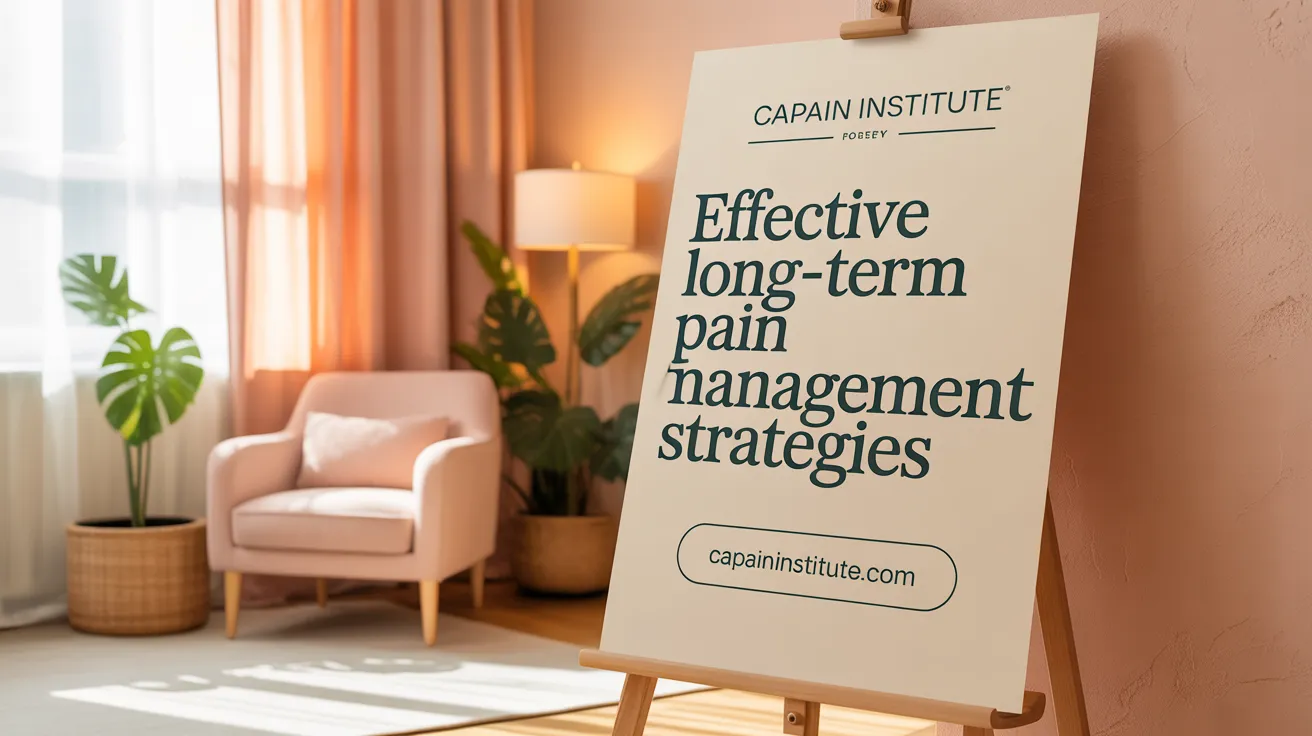
What are effective long-term management strategies for chronic pain?
Managing chronic pain over the long term requires a coordinated approach that addresses the many aspects of a person’s health and daily life. There is no one-size-fits-all solution; instead, a combination of therapies and lifestyle changes is essential.
A central part of treatment involves tailored medication plans. These may include non-opioid analgesics, adjuvant medications like antidepressants or anticonvulsants, and sometimes opioids, but only when carefully considered and monitored. Medications are most effective when combined with other therapies to minimize side effects and risks.
Physical exercises and movement therapies are crucial. Gentle activities such as walking, swimming, yoga, or tai chi help improve flexibility, strengthen muscles, and reduce pain sensitivity. Physical therapy can also target specific issues like joint problems or muscle weakness, contributing to better function and less reliance on medication.
Psychological interventions are an integral component. Techniques like cognitive-behavioral therapy (CBT), mindfulness, relaxation methods, and support groups help individuals develop coping skills, reduce stress, and manage emotional challenges associated with chronic pain. These mental health tools can significantly improve overall well-being.
Lifestyle modifications include maintaining a healthy weight, practicing good sleep hygiene, reducing stress, and avoiding substances like alcohol and tobacco that can worsen pain or interfere with treatment. Consistent sleep and stress management are especially important, as poor habits can amplify pain sensations.
Ongoing assessment and education are necessary to adapt treatment plans to life changes and progress. Regular consultations with healthcare providers ensure therapies remain effective and safe.
In conclusion, long-term pain management benefits from a comprehensive approach that combines medication, physical activity, psychological support, and lifestyle habits. This integrated strategy aims to improve function, reduce pain symptoms, and enhance quality of life despite persistent pain.
Psychological and Emotional Coping Mechanisms in Pain Management
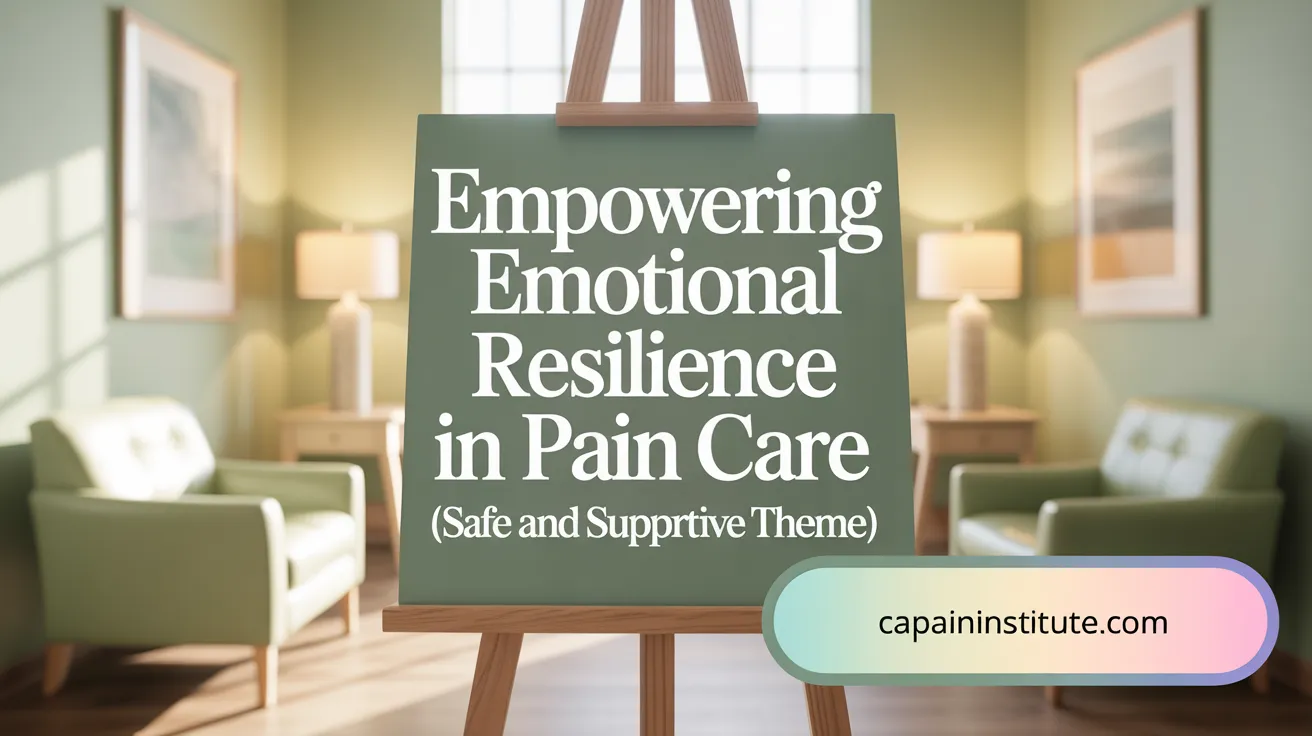
How can psychological and emotional coping mechanisms help in managing chronic pain?
Managing chronic pain extends beyond physical treatments—it also involves addressing the mental and emotional aspects of living with persistent discomfort. Psychological and emotional coping strategies are essential tools that help individuals better handle the stresses and emotional challenges associated with long-term pain.
One of the most effective approaches is cognitive-behavioral therapy (CBT). This type of therapy helps patients reframe negative thoughts about pain, reduce feelings of frustration or hopelessness, and develop practical skills to manage symptoms. By changing thought patterns, patients can alter their emotional responses and improve their resilience.
Mindfulness and relaxation techniques, such as deep breathing, meditation, and progressive muscle relaxation, are also powerful. These practices promote relaxation, lower muscle tension, and diminish anxiety, which can worsen pain sensations. Regularly engaging in these activities can help patients achieve a sense of calm and control.
Emotional regulation strategies involve managing emotions effectively, preventing them from escalating stress or pain levels. Techniques like journaling, positive self-talk, and stress management exercises support emotional stability.
Social and peer support further enhances coping. Joining support groups or connecting with others facing similar challenges provides validation, shared experiences, and encouragement. Knowing they are not alone helps reduce feelings of isolation and builds a sense of community.
The impact of these psychological strategies on pain perception is significant. By addressing emotional distress, patients often report a decrease in perceived pain intensity, improved mood, and increased ability to participate in daily activities.
In summary, integrating psychological and emotional coping methods empowers individuals with chronic pain to manage their condition more effectively. These strategies help reduce distress, foster acceptance, and improve overall quality of life despite ongoing symptoms.
Nonpharmacological Therapies: Safe and Effective Pain Relief Alternatives
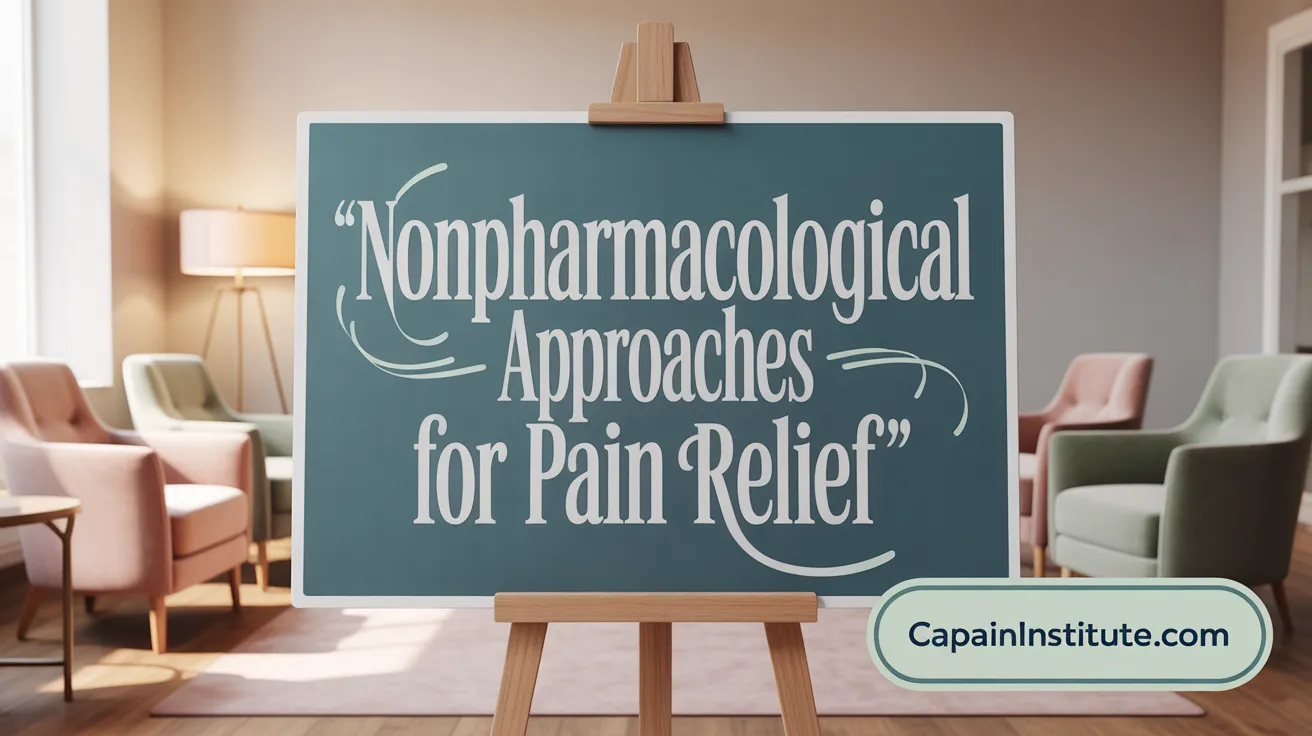
What nonpharmacological therapies are recommended for chronic pain relief?
Managing chronic pain effectively often involves more than just medications. Nonpharmacological therapies play a crucial role in reducing pain, improving function, and addressing both physical and emotional aspects of living with persistent pain.
These approaches include various exercise modalities like aerobic activities, resistance training, and aquatic exercises. Such movements help strengthen muscles, improve flexibility, and diminish pain signals. Gentle activities like walking, swimming, and water-based exercises, in particular, are beneficial for maintaining mobility without overexerting the body.
Mind-body practices are also highly recommended. Techniques such as yoga, tai chi, and qigong combine gentle movement, breathing, and meditation to reduce stress and lower pain levels. These practices are accessible at many facilities and can be tailored to individual fitness levels.
Psychological therapies are essential, especially when emotional distress exacerbates pain. Cognitive-behavioral therapy (CBT), acceptance and commitment therapy, and mindfulness-based stress reduction help patients develop healthier coping strategies, manage stress, and modify perceptions of pain.
Physical modalities include therapies such as acupuncture, massage, manual therapy, transcutaneous electrical nerve stimulation (TENS), and low-level laser therapy. These treatments aim to stimulate healing, reduce muscle tension, and modulate pain signals.
Multidisciplinary rehabilitation programs incorporate physical therapy, counseling, and education. These comprehensive plans address the complex nature of chronic pain, helping individuals regain function and improve quality of life.
In addition to structured therapies, education on pain management techniques, relaxation exercises, sleep hygiene practices, and manual therapies can be effective adjuncts. Emerging digital tools like virtual reality therapies are also being investigated for their potential to distract from pain and promote relaxation.
Overall, nonpharmacological therapies are often recommended as the first line or complementary treatments because they carry minimal risks and offer holistic benefits. Integrating these approaches into a personalized treatment plan can lead to sustained improvements and a better quality of life for those living with chronic pain.
Medication Management and Ongoing Review for Safety and Efficacy
What role does medication management and review play in long-term chronic pain treatment?
Medication management is a crucial aspect of controlling chronic pain over the long term. Since chronic pain often requires ongoing treatment, regular reviews help ensure that medications continue to provide pain relief while minimizing potential harms.
Healthcare providers routinely evaluate how well the prescribed medications are working and look out for any adverse side effects. This ongoing assessment includes checking for signs of medication misuse, dependency, or escalation, especially with opioids and nonsteroidal anti-inflammatory drugs (NSAIDs). Monitoring organ functions, such as liver and kidney health, is an essential part of this process.
Adjustments to medication types and doses are made based on how the patient responds and any new symptoms that develop. Combining medication with nonpharmacologic therapies, like physical therapy and psychological support, enhances treatment effectiveness.
Regular reviews foster a safe and effective treatment plan by ensuring the benefits of pain relief outweigh the risks. This multidisciplinary approach supports better overall outcomes and reduces the likelihood of medication-related complications.
How do balancing benefits and risks influence long-term pain management?
Finding the right balance involves carefully considering the positive effects of pain relief against potential side effects or dependence risks. For example, while opioids can provide significant relief, their long-term use demands cautious monitoring due to the possibility of tolerance and addiction.
Strategies such as dose limitation, medication rotation, and periodic medication holidays can help mitigate these risks.
The importance of monitoring side effects and organ function
Routine blood tests and clinical assessments are performed to detect early signs of organ damage, cardiovascular issues, or metabolic disturbances. Tracking these parameters helps prevent serious complications and informs necessary adjustments.
Opioid stewardship in chronic pain
Given the risks associated with opioids, many guidelines advocate for responsible prescribing—also known as opioid stewardship—which involves only using opioids when clearly beneficial, for the shortest duration necessary, and under strict supervision.
Embracing integrated approaches
Effective long-term management combines medication review with physical, psychological, and social strategies. Regular communication among healthcare providers ensures that treatment remains tailored to the evolving needs of the patient.
| Aspect | Focus Area | Additional Notes |
|---|---|---|
| Regular assessment | Effectiveness, side effects, risks | Ongoing evaluations to adapt treatment plans |
| Organ function monitoring | Liver, kidney, cardiovascular health | Blood tests, clinical exams |
| Risks and safety | Dependence, misuse, adverse reactions | Implementation of stewardship programs |
| Multidisciplinary approach | Combining therapies | Physical, psychological, and social support |
Understanding the role of medication review ensures that chronic pain treatment remains safe, effective, and responsive to the patient's changing needs, ultimately improving quality of life.
Innovations in Pain Assessment and Research Advancing Management
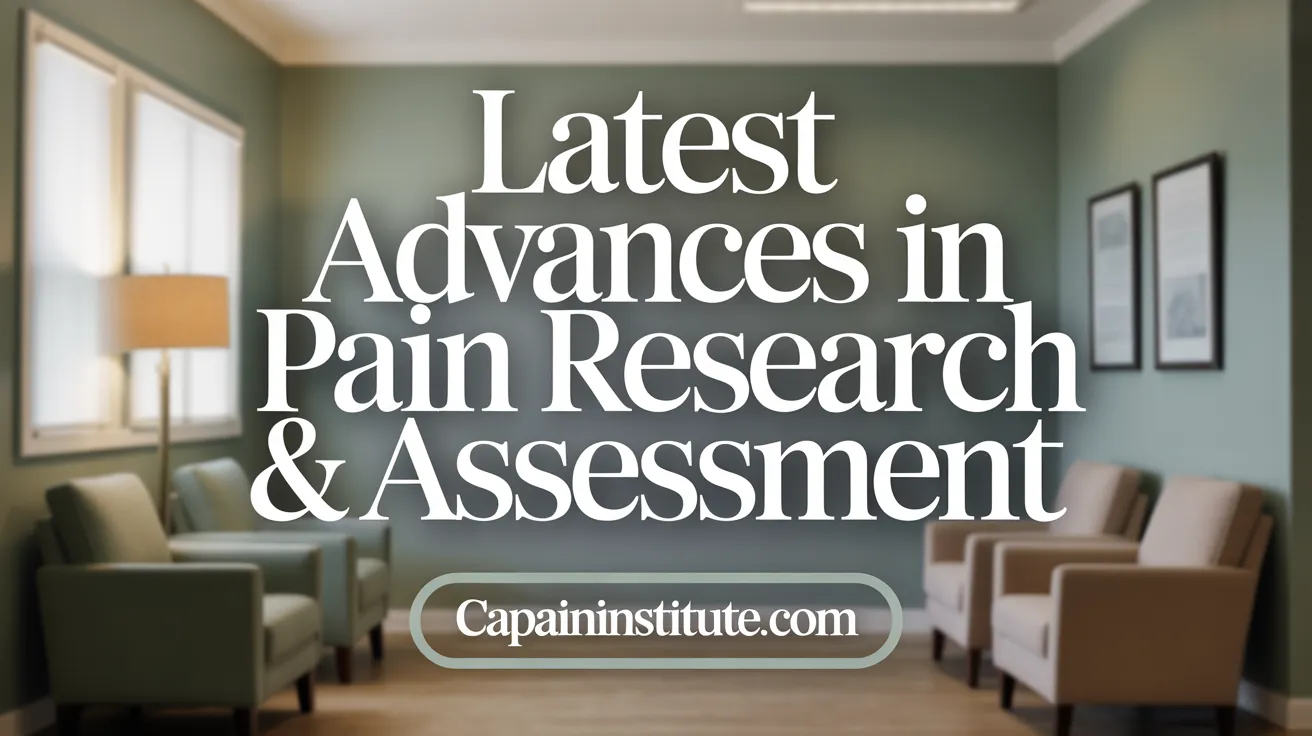
What recent research findings and assessment methods have advanced effective chronic pain management?
Recent developments in chronic pain assessment are transforming how healthcare providers understand and treat persistent pain. Instead of relying solely on patient self-reporting, innovative tools now capture the multifaceted nature of pain, which includes biological, psychological, and social factors. Tools like multidimensional questionnaires, such as the McGill Pain Questionnaire, offer detailed insights into the type, intensity, and emotional impact of pain.
Emerging technologies facilitate real-time monitoring of pain fluctuations through mobile applications and wearable devices. These dynamic assessment methods provide a more nuanced picture, helping clinicians tailor treatments to individual needs. Additionally, AI-driven models analyze complex data patterns, enabling more accurate predictions of pain trajectories and responses to treatment.
Clinical research demonstrates that combining these assessment techniques with multimodal therapies—encompassing medication, psychological counseling, physical therapy, and advanced treatments like neurostimulation or virtual reality—optimizes patient outcomes. Studies have shown reductions in pain severity, decreased reliance on opioids, and fewer hospitalizations when personalized strategies are employed.
Furthermore, implementation science is instrumental in translating research into practice. It identifies barriers within healthcare systems, especially in primary care, and develops strategies to effectively incorporate non-drug-based interventions. This approach emphasizes a shift toward understanding the dynamic process of pain and customizing care in real time.
In summary, recent advancements focus on process-oriented, personalized, and technology-enabled assessments. These innovations foster a deeper understanding of chronic pain's complexity, ultimately leading to more effective, individualized management strategies.
Special Considerations: Tailoring Pain Management for Veterans and Those with Addiction History
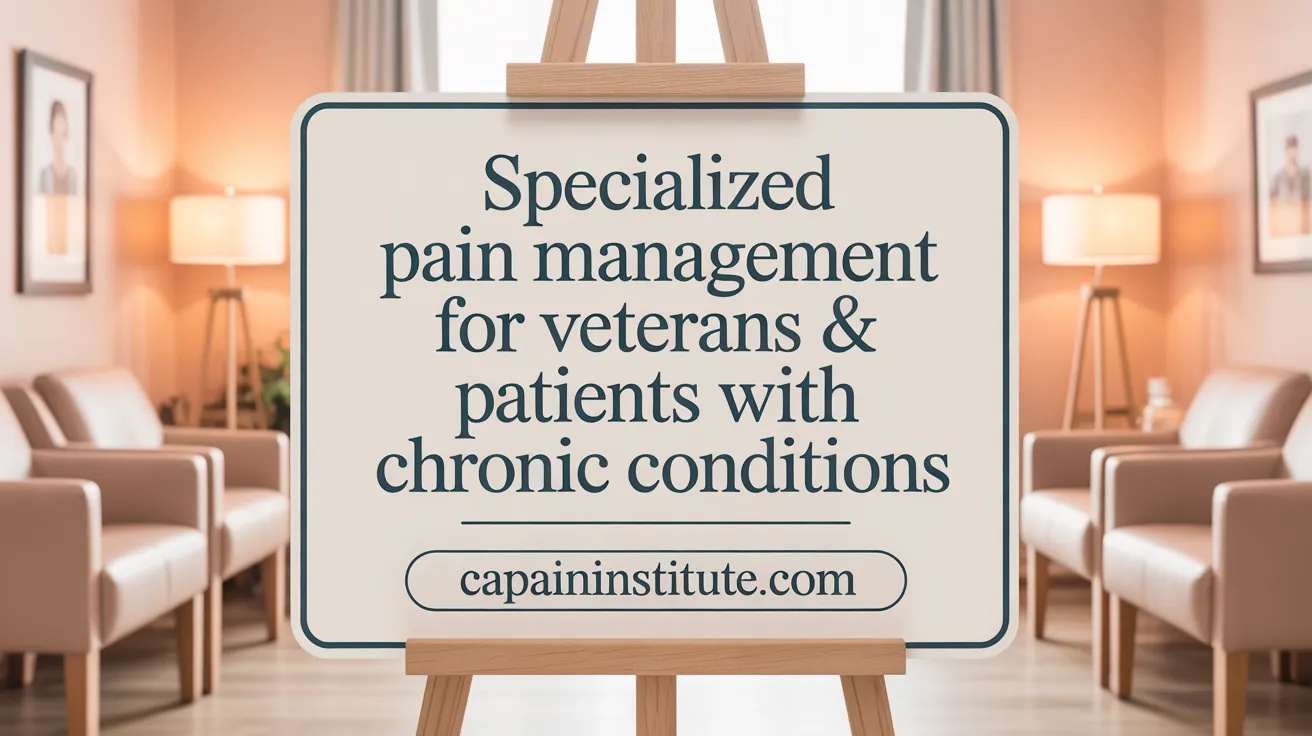
How prevalent is chronic pain among veterans?
Chronic pain is a significant concern for military veterans, especially those from Gulf War, Desert Shield, and Desert Storm deployments. It affects about two out of every seven veterans, making it a common long-term health issue within this group.
How can veterans access specialized therapies like yoga and support groups?
Veterans are often encouraged to explore non-medication treatments, such as yoga, which can help reduce stress and alleviate pain. Many VA facilities offer yoga classes tailored for veterans, alongside support groups where individuals share experiences and coping strategies. Participation can improve mental well-being and provide a sense of community.
How is pain managed in individuals with a history of addiction?
For veterans with a history of substance use disorder, managing chronic pain requires careful planning. Opioid therapy, if considered, must be monitored closely and is usually only prescribed when the benefits outweigh the risks. Alternative treatments like physical therapy, psychological support, and medication-assisted therapies (e.g., buprenorphine or methadone) are prioritized.
Why is collaboration with addiction specialists important?
Collaborative care involving addiction treatment specialists is essential for safely managing pain in individuals with active or previous substance use issues. These professionals help develop personalized plans that address both pain and addiction, aiming to reduce relapse risk and ensure effective symptom control.
Why is individualized, comprehensive care crucial?
Every veteran’s experience with pain and addiction is different. An integrated, tailored approach combining medical, psychological, and physical therapies ensures that treatments are effective and safe. This comprehensive care maximizes the chances of improving quality of life and reducing pain symptoms.
| Aspect | Details | Additional Insights |
|---|---|---|
| Pain Prevalence | 2 in 7 veterans affected | Especially Gulf War and Desert Storm veterans |
| Therapies | Yoga, support groups, physical therapy | Offered at VA facilities, supporting mental and physical health |
| Pain Management | Medication with caution, alternative therapies | Emphasizes safety and individualized plans |
| Specialist Collaboration | Addiction specialists, mental health professionals | Ensures comprehensive, safe care |
| Care Approach | Personalized, multidisciplinary | Combines medical, psychological, and physical therapies |
Towards a Better Quality of Life with Chronic Pain
While chronic pain often persists over many years, advances in multidisciplinary treatment strategies offer hope for improved daily functioning and emotional well-being. Combining tailored medical therapies with physical, psychological, and lifestyle interventions empowers individuals to regain control and enhance quality of life. Ongoing research continues to refine pain management approaches, emphasizing personalization and integration of care. Patients, caregivers, and healthcare providers alike benefit from embracing comprehensive plans and supportive resources, fostering resilience and meaningful living despite chronic pain's challenges.
References
- Tips for managing chronic pain
- Chronic Pain: What It Is, Symptoms, Treatment ...
- 10 ways to reduce pain
- Chronic Pain Management
- What are the Most Effective Coping Strategies for ...
- 10 Ways to Manage Your Chronic Pain - Public Health
- Pain Self-Management Strategies
- Pain and pain management – adults
- Coping with chronic pain
- Living with chronic pain
